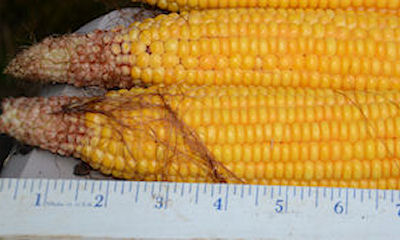September 2, 2015

Rains during June and July set new records in some areas of the Corn Belt this year, causing weak root development and nitrogen loss. It even affected pollination in some fields with poor ear-tip fills.
Related: Diplodia Ear Rot is a corn ear mold to watch for now
Leaf diseases like northern corn leaf blight and gray leaf spot were rampant in some areas causing additional stress on the corn crop. Some of the effects of this stressful environment on grain-fill are indicated here.
This isn't an all-inclusive list – there may be other ramifications as well.
Reason for bare tips: At one point the plant thought it could fill this ear with kernels. Some sort of stress caused it to abort tip kernels to make sure it could fill other kernels properly.
• After pollination, we need 50-60 days depending on the relative maturity of the hybrid, for the grain-fill period. This is when the plant's primary focus is to fully develop the kernels.
• If there is severe heat, moisture or disease stress during the grain-fill period, the plants start to cannibalize their leaves and stalks to fulfill the growing needs of their progeny, the seeds or grain.
• Plants, like animals, don't want to produce runts. So, if there is stress during the grain-fill period, the plants start to abort the youngest kernels causing tip die-backs so that the remaining kernels can fully develop.
• Foliar fungicides are most effective if sprayed after the pollination and ovule fertilization is completed. This usually means waiting until brown silks appear. Leaves above the ear contribute the most to grain yield; so it's important to keep them healthy and disease-free during the grain-fill period.
• The physiologic maturity or black layer occurs at about 32-35% grain moisture. Stress before this period can cause kernel abortion and light test weight. Kernels will not have as much weight packed into them.
• If plants divert the nutrients from stalks to "feed" the grain, it can lead to pre-mature death and susceptibility to stalk rot organisms.
Related: Thick corn populations require right genetics
Keep scouting the fields, check them for stalk rots and plan on which fields to harvest first. Scouting doesn't end until the corn crop is in the bin or delivered to the elevator.
Nanda is a consultant with Seed Consultants. He writes from Indianapolis.
You May Also Like




